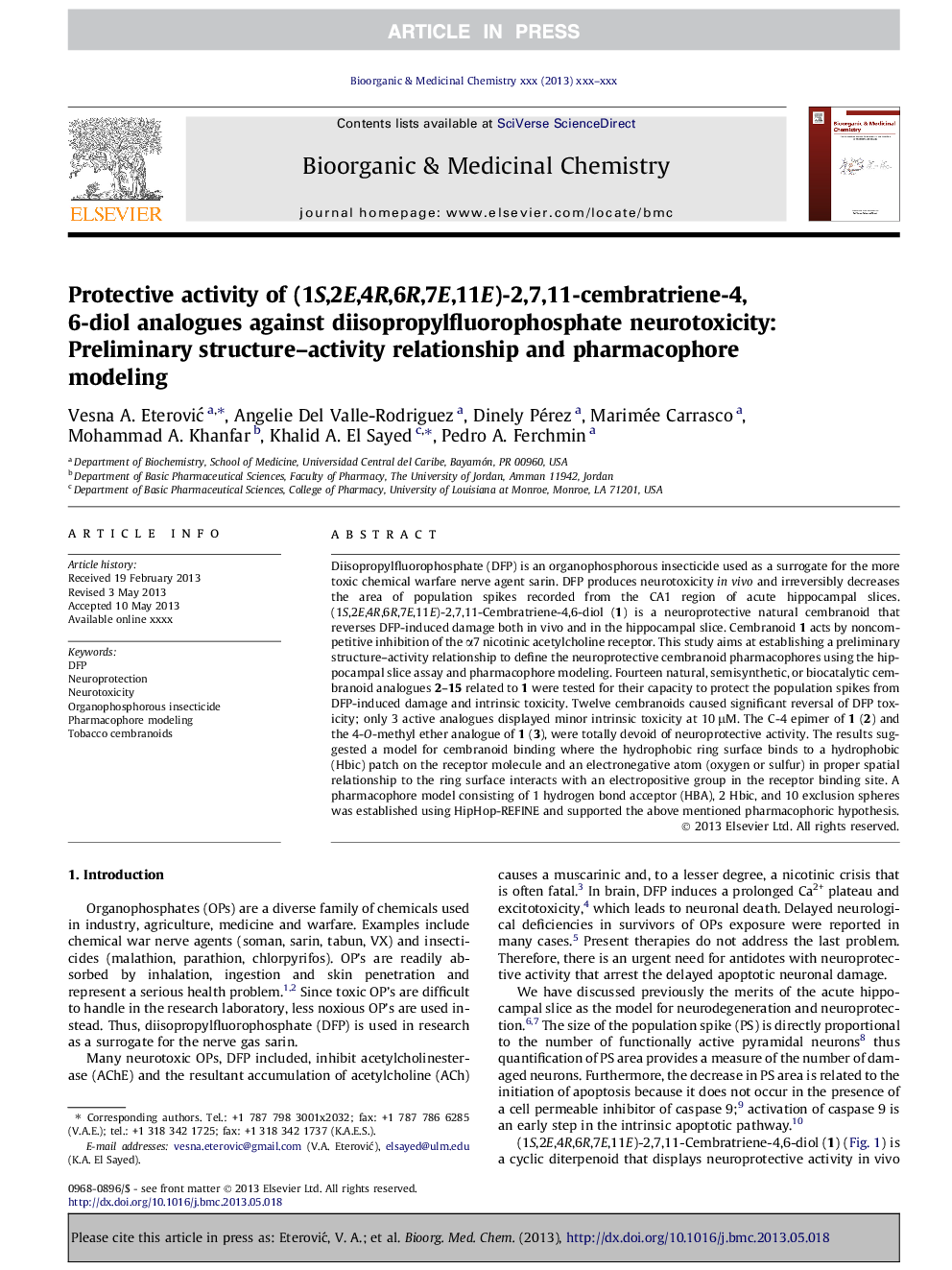| کد مقاله | کد نشریه | سال انتشار | مقاله انگلیسی | نسخه تمام متن |
|---|---|---|---|---|
| 10586049 | 981383 | 2013 | 9 صفحه PDF | دانلود رایگان |
عنوان انگلیسی مقاله ISI
Protective activity of (1S,2E,4R,6R,7E,11E)-2,7,11-cembratriene-4,6-diol analogues against diisopropylfluorophosphate neurotoxicity: Preliminary structure-activity relationship and pharmacophore modeling
دانلود مقاله + سفارش ترجمه
دانلود مقاله ISI انگلیسی
رایگان برای ایرانیان
کلمات کلیدی
موضوعات مرتبط
مهندسی و علوم پایه
شیمی
شیمی آلی
پیش نمایش صفحه اول مقاله

چکیده انگلیسی
Diisopropylfluorophosphate (DFP) is an organophosphorous insecticide used as a surrogate for the more toxic chemical warfare nerve agent sarin. DFP produces neurotoxicity in vivo and irreversibly decreases the area of population spikes recorded from the CA1 region of acute hippocampal slices. (1S,2E,4R,6R,7E,11E)-2,7,11-Cembratriene-4,6-diol (1) is a neuroprotective natural cembranoid that reverses DFP-induced damage both in vivo and in the hippocampal slice. Cembranoid 1 acts by noncompetitive inhibition of the α7 nicotinic acetylcholine receptor. This study aims at establishing a preliminary structure-activity relationship to define the neuroprotective cembranoid pharmacophores using the hippocampal slice assay and pharmacophore modeling. Fourteen natural, semisynthetic, or biocatalytic cembranoid analogues 2-15 related to 1 were tested for their capacity to protect the population spikes from DFP-induced damage and intrinsic toxicity. Twelve cembranoids caused significant reversal of DFP toxicity; only 3 active analogues displayed minor intrinsic toxicity at 10 μM. The C-4 epimer of 1 (2) and the 4-O-methyl ether analogue of 1 (3), were totally devoid of neuroprotective activity. The results suggested a model for cembranoid binding where the hydrophobic ring surface binds to a hydrophobic (Hbic) patch on the receptor molecule and an electronegative atom (oxygen or sulfur) in proper spatial relationship to the ring surface interacts with an electropositive group in the receptor binding site. A pharmacophore model consisting of 1 hydrogen bond acceptor (HBA), 2 Hbic, and 10 exclusion spheres was established using HipHop-REFINE and supported the above mentioned pharmacophoric hypothesis.
ناشر
Database: Elsevier - ScienceDirect (ساینس دایرکت)
Journal: Bioorganic & Medicinal Chemistry - Volume 21, Issue 15, 1 August 2013, Pages 4678-4686
Journal: Bioorganic & Medicinal Chemistry - Volume 21, Issue 15, 1 August 2013, Pages 4678-4686
نویسندگان
Vesna A. EteroviÄ, Angelie Del Valle-Rodriguez, Dinely Pérez, Marimée Carrasco, Mohammad A. Khanfar, Khalid A. El Sayed, Pedro A. Ferchmin,